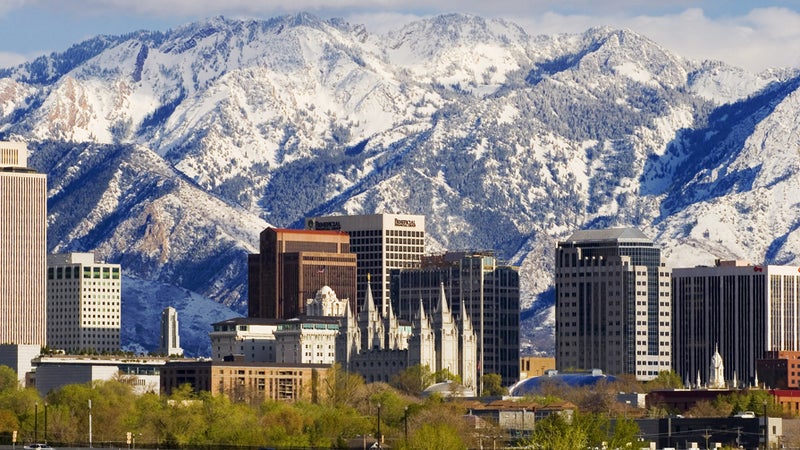Back when there were more shirtless men at the Outdoor Retailer show than you’ll find on today’s ���ϳԹ��� magazine covers, Boulder was oft derided with much snark as “The Center of the Universe.”
Today, it’s still easy to assume that Boulder specifically and Colorado in general are the center of the outdoor industry universe. Meh, not so fast. Tents, footwear, energy gels, apparel, boutique startups, bikes—Colorado represents in all the major and minor categories, but it’s by no means dominant. The North Face is in California, REI is in Washington, and Trek is in Wisconsin.
We’re talking about a widely dispersed, $120-billion industry—in product sales alone. According to the , 20 percent of US manufacturing jobs are outdoor-based. Throw in every line of outdoor industry work—from fly fishing guides to ski area lifties to snowmobile repairs—and the sum contribution is 6.1 million outdoor jobs. To , “I don’t know how to put this, but we’re kind of a big deal.”
What you might not know is that, especially out West, states are actually competing for these jobs, and nowhere is that contest more pronounced than in the battle for snowsports business waging right now between Utah and Colorado. Turns out Americans spend $53 billion annually on snowsports. That’s a lot of spiky helmet covers. It’s also a lot of lift tickets, skis, avalanche shovels, beacons, freeride boots, gloves, and mid-weights.
“When we were looking for a home for Dynafit North America, it came down to Utah versus Colorado. There’s great skiing in both states, but we had to base our decision on our ability to grow a top outdoor company. The Boulder area has 2.5 times the population, and is top 10 in terms of education—versus 50-plus for Salt Lake.”
A little more than 10 years ago, —the enterprising mayor of Ogden, Utah at the time—began recruiting snow industry “job creators” with the promise of low taxes, established infrastructure, and easy-to-access face shots at nearby Snowbasin and Powder Mountain—both just 20 minutes away. “We’re going to out-Boulder Boulder,” he said when he cold called me once to see if I’d be interested in moving the magazine I edited to the Beehive State. Having skied Snowbasin, I knew he was onto something. Having tried to buy cold beer in Ogden, I thought there might be some hang-ups.
As it played out, “The Hub,” as Godfrey rebranded the place (it used to be a railroad hub), had some legit appeal. North American operations for Atomic, Salomon, Suunto, and Descente are now headquartered there. And Utah-based (but Euro-owned) companies Rossignol, Dynastar, Lange, and Scott maintain offices and distribution centers in town. There are now 12 recognizable outdoor brands in the Hub. There’s also readily available mountain biking and trail running in summer. The river’s been cleaned up and the downtown is borderline vibrant. And Snowbasin and Powder Mountain are big empty resorts. For all those reasons, Ogden had the nation’s fastest job growth in 2011.
To the south in Salt Lake City, there’s Black Diamond Equipment, Voile, and Backcountry.com—a few more major Utah players heavily invested in the snowsports business. Would any of them be there if not for Alta, Snowbird, and the 500-plus inches of fluff that falls on the Wasatch? Not a chance.
“You can still buy a nice house, running or riding distance from a trail system and 20 minutes from skiing, for less than $200,000,” says Ogden resident Derek Taylor, former editor of Powder magazine and current editor of . “But don’t forget that Ogden’s world class. How world class? It’s the only place on the planet where you can see the backside of an Olympic ski venue from both an In-N-Out Burger and a Dunkin’ Donuts…Sure, you can buy weed in Boulder. But what good is that if you can’t get In-N-Out and Dunks? What are you going to do—get high and eat organic granola and go ski Eldora? Please.”
Sounds like Utah—and Ogden specifically—is winning. But across the Continental Divide, Boulder is responding—by remaining as aloof as your typical Boulderite. There are no big tax incentives to relocate your outdoor business to town. And while the Boulder Economic Council has said that attracting and retaining outdoor businesses is one of its top priorities, the most officials can point to as bait—other than the vast acreage of open space around town—is a $350,000 flexible rebate program (that’s the total budget) that gets doled out to a handful of companies annually. Like the people employed in the snowsports and outdoor industries, those businesses are moving to the edges of town, and farther out into Boulder County. (Pearl Izumi and Shimano just built impressive new office spaces in Louisville.)
Still, the snowsports business growth continues. Backcountry Access and La Sportiva have been in Boulder for years. More recently, Scarpa, Dynafit, and Head have relocated to the city where the average house sells for $640,000. Wax technicians are apparently well paid.
is the rare outdoor company to set up shop in downtown Boulder—as opposed to the industrial parks by the railroad tracks.
“When we were looking for a home for Dynafit North America in 2007, it came down to Utah versus Colorado,” says President of Dynafit North America Chris Sword. “There’s great skiing in both states, obviously, but we had to base our decision on our ability to grow a top outdoor company. The Denver/Boulder area has 2.5 times the population, and is top 10 in terms of education—versus 50-plus for Salt Lake. Salt Lake had zero European flights. Denver had multiple. I love skiing Wasatch powder too, but we need more than an In-N-Out Burger to thrive.”
So who’s going to win the Wasatch-Front-versus-Front-Range wintry smackdown? Here’s the tale of the tape:
Snowfall
Colorado: Vail gets on average 348 inches annually.
Utah: Alta? 550 inches.
Advantage: Utah. To be fair, Silverton and Wolf Creek get way more snow than Vail. But to be honest, you can drive to Utah faster than you can get to the San Juans.
������
Colorado: Oskar Blues Old Chub Scottish Ale is 8% alcohol. And it comes in a can!
Utah: Even Wasatch Brewery’s much lauded Polygamy Porter is a 3.2 beer. I’ve heard Colorado kindergartens serve 3.2 beer to kids who are lactose intolerant.
Advantage: Colorado. Alcohol is the secret ingredient that makes beer taste like beer.
Access
Colorado: When the snow is really good in Colorado, the driving is really bad. Try six and seven hour commutes to ski areas that are supposed to be a two-hour drive away.
Utah: Ogden is so close to skiing it’s almost got a gondola. Salt Lake should think about it.
Advantage: Utah. If not for Eldora and Loveland (35 to 50 minutes), it would be tough to be a Front Range skier. Even the backcountry is hard to get to. Dawn patrols in Colorado are technically dawn to dusk patrols.
Cultivation
Colorado: With the recent legalization of marijuana, there are reports of hour-long waits in Breckenridge—at the weed shop.
Utah: “You go into Utah now with Colorado license plates, and you’ll get pulled over and one of the first questions they’re going to ask is, ‘How much marijuana do you have?’” Jesse Loughman, owner of the Palisade medical marijuana dispensary Colorado Alternative Health Care, .
Advantage: Colorado.


